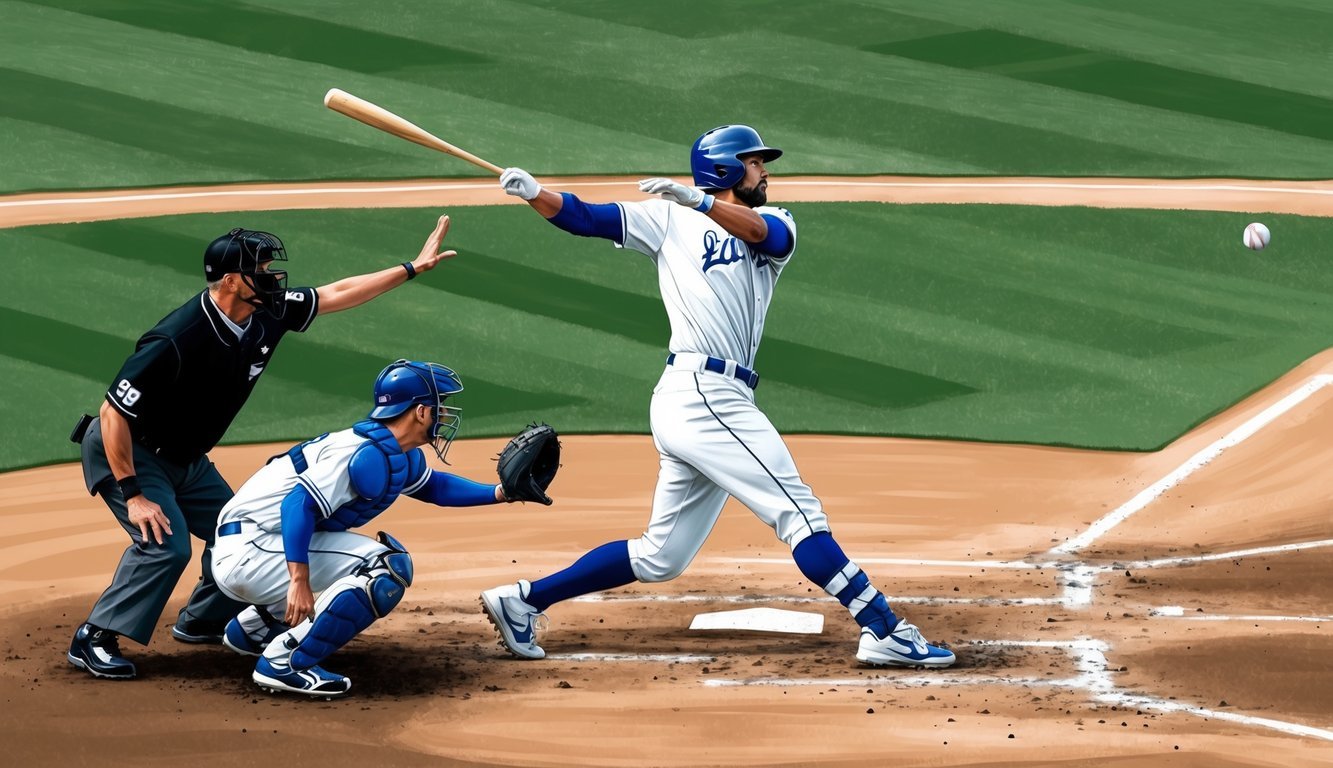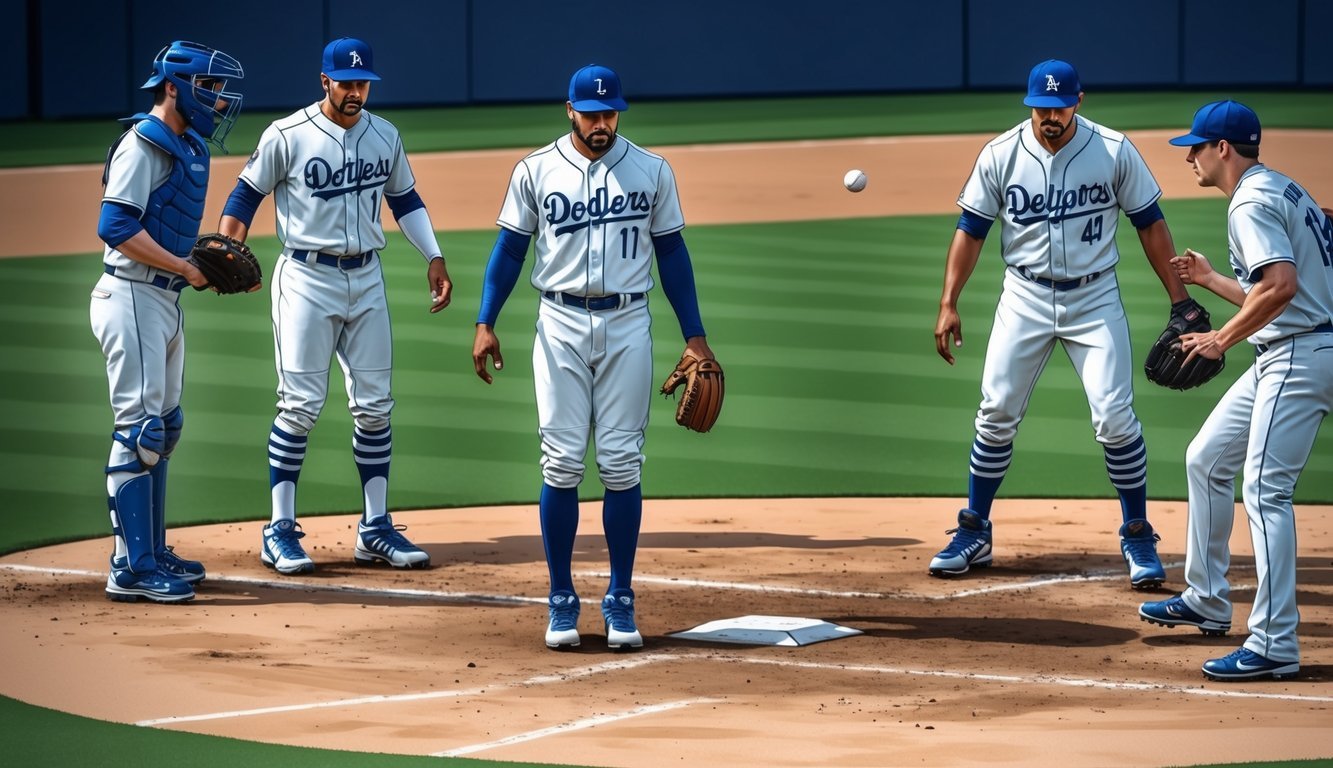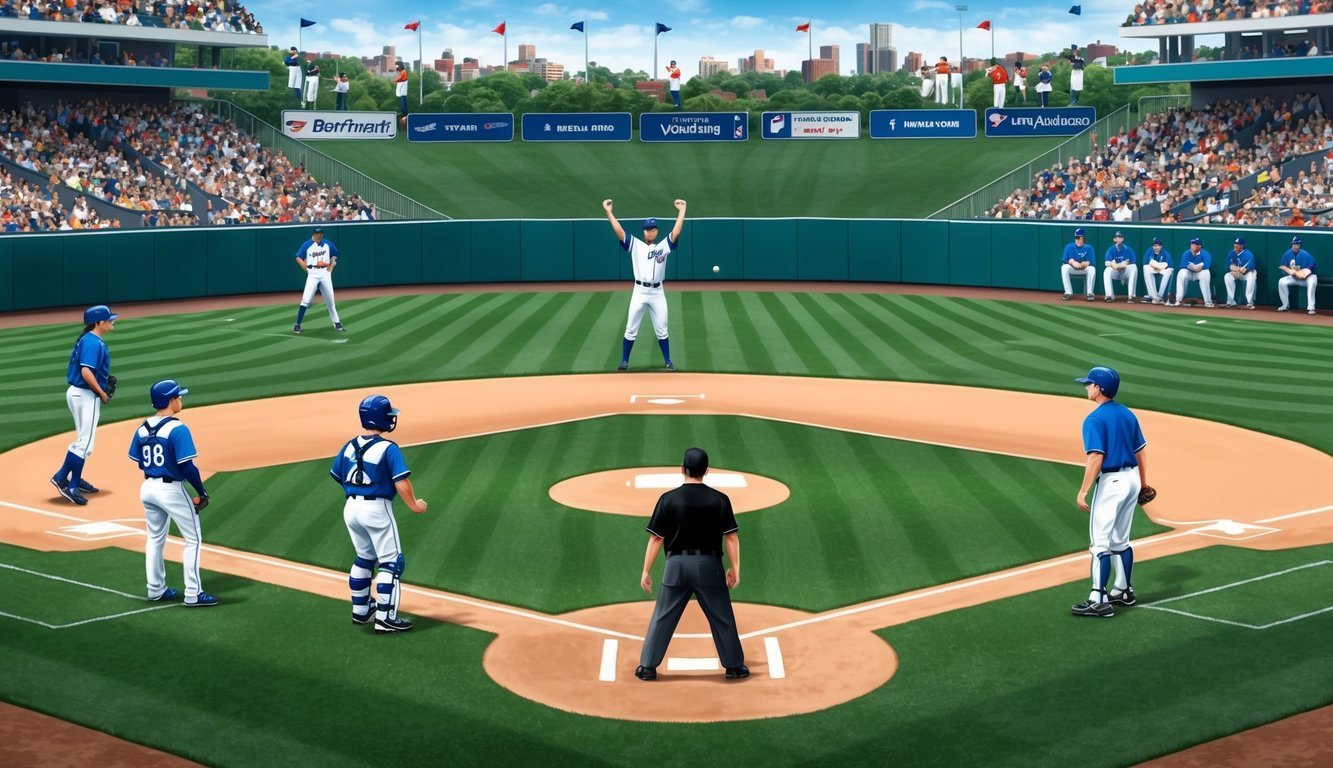Baseball is full of nuanced rules, and one of the most perplexing for fans and players alike is the infield fly rule.
This unique regulation aims to prevent fielders from intentionally dropping pop-ups to turn easy double plays. The infield fly rule automatically calls the batter out on certain pop-ups with runners on base, even if the ball is not caught.
The rule comes into play when there are runners on first and second (or bases loaded) with less than two outs.
If a batter hits a pop-up in the infield that can be caught with ordinary effort, the umpire will declare “Infield fly!” The batter is immediately out, regardless of whether the ball is caught.
Understanding this rule can make watching baseball games more enjoyable, as it often leads to interesting situations on the field.
Players and managers must be aware of when the infield fly rule is in effect, as it can significantly impact baserunning decisions and defensive strategies.
Basics of the Infield Fly Rule
The infield fly rule is a crucial aspect of baseball that protects baserunners and maintains fair play.
It comes into effect under specific conditions and impacts both offensive and defensive strategies.
What Constitutes an Infield Fly
An infield fly occurs when there are runners on first and second base (or bases loaded) with less than two outs.
The batter hits a fair fly ball that can be caught by an infielder with ordinary effort.
The umpire must call “Infield Fly” immediately.
This rule applies even if an outfielder catches the ball in the infield area.
The batter is automatically out, regardless of whether the ball is caught.
Runners may advance at their own risk, just as on any fly ball.
Roles and Responsibilities
The umpire plays a key role in enforcing the infield fly rule.
They must quickly assess if the hit qualifies and make the call promptly.
Infielders should attempt to catch the ball as usual.
Deliberately dropping it doesn’t negate the rule’s effect.
Baserunners need to stay alert.
They can advance if the ball isn’t caught, but must tag up if it is.
The batter is out once the call is made, even if the ball drops untouched.
Coaches should ensure players understand the rule to avoid confusion during games.
Infield Fly Rule Conditions
The infield fly rule comes into play under specific circumstances during a baseball game.
It aims to prevent fielders from intentionally dropping pop-ups to turn easy double plays.
Runners on Base
For the infield fly rule to be in effect, there must be runners on first and second base or the bases must be loaded.
This creates a force play situation at third base.
The rule doesn’t apply when there’s only a runner on first.
It’s crucial to have less than two outs in the inning for the rule to be invoked.
When these conditions are met, the umpire can call “infield fly” on pop-ups or fly balls that an infielder could catch with ordinary effort.
The batter is automatically out, even if the ball isn’t caught.
This protects the runners from being forced into a double play.
Outfield Involvement
While it’s called the infield fly rule, it’s not limited to the infield dirt.
The rule can apply to pop-ups hit to the outfield grass if an infielder could make the play with ordinary effort.
This judgment call by the umpire takes into account factors like the ball’s trajectory and the fielder’s position.
In modern baseball, with defensive shifts becoming more common, outfielders might be positioned in the infield.
In these cases, they’re treated as infielders for the purposes of the infield fly rule.
The key is whether the fly ball is catchable with ordinary effort by an infielder, regardless of who actually attempts to make the play.
Implementing the Rule

The infield fly rule relies on split-second decisions and clear communication between umpires and players.
Proper implementation ensures fair play and prevents confusion on the field.
Umpire’s Call
When conditions for an infield fly are met, the umpire must act quickly.
They assess if an infielder can catch the ball with ordinary effort.
This judgment call considers factors like ball height, speed, and trajectory.
The umpire loudly declares “Infield fly!” or “Infield fly, if fair!” They also signal by raising an arm.
This alert notifies players, coaches, and fans of the ruling.
Timing is crucial.
The call should be made as soon as possible, ideally when the ball reaches its peak.
This gives baserunners time to react.
After the Call
Once called, the infield fly rule remains in effect even if the ball is not caught.
Runners can advance at their own risk, just like on any fly ball.
If the ball lands foul, it’s treated as a regular foul ball.
The batter isn’t out, and play resumes.
Fielders can still attempt to catch the ball.
A successful catch doesn’t change the batter’s out status but may lead to additional outs if runners don’t tag up.
Runners should be alert.
They can advance if the ball is dropped, but must tag up if it’s caught.
Consequences of the Infield Fly

The infield fly rule impacts both offensive and defensive strategies in baseball.
It creates unique scenarios for runners and fielders alike, shaping how plays unfold.
Offensive teams often adjust their tactics when they anticipate an infield fly situation, as it can result in automatic outs and influence base-running decisions.
Defensively, players must be vigilant and aware of the rule to avoid misplays that could grant the offense an advantage.
This brings up questions for players and fans alike, such as “does a sac fly count as at bat,” which can further complicate scoring and individual statistics during the game.
Runners’ Options
When an infield fly is called, runners face a crucial decision.
They can choose to stay on their base or attempt to advance at their own risk.
If the ball is caught, runners must tag up before advancing.
However, if the ball drops, they’re not forced to run.
This rule prevents the defense from intentionally dropping the ball to turn an easy double or triple play.
Savvy baserunners might use the infield fly situation to their advantage.
If the fielder misplays the ball, alert runners can take an extra base.
But caution is key – aggressive baserunning can backfire if the defense recovers quickly.
Defensive Scenarios
The infield fly rule shifts defensive priorities.
Instead of focusing on a double play opportunity, fielders must concentrate on catching the ball.
This change can lead to interesting outcomes.
If a fielder drops an infield fly, they can still attempt to get outs on runners who advance.
However, the batter is already out, reducing the potential for multiple outs.
Smart defenders might let a difficult infield fly drop if they have a chance to get a lead runner trying to advance.
The rule also impacts positioning.
Infielders might play deeper to have a better chance of catching pop-ups.
Outfielders need to be ready to back up infield players in case of a misplayed ball.
Historical Context and Notable Moments

The infield fly rule has a rich history in baseball, evolving from its origins in the 19th century to become an integral part of the modern game.
This rule has led to some unforgettable moments on the field, sparking debates and shaping strategy.
The infield fly rule basics dictate that when there are runners on first and second, or the bases are loaded, and a fair fly ball is caught by an infielder, the batter is automatically out.
This rule is designed to prevent fielders from taking advantage of base runners by intentionally dropping the ball to create a double play.
Understanding the infield fly rule is crucial for players and fans alike, as it can dramatically influence the momentum of a game in critical situations.
The Origin of the Rule
The infield fly rule emerged in the late 1800s to prevent fielders from intentionally dropping pop-ups to turn easy double plays.
In 1895, the National League officially adopted the rule.
Its introduction addressed a growing concern about unfair tactics that gave the defense an undue advantage.
The rule’s implementation wasn’t without challenges.
Early versions lacked clarity, leading to confusion among players and umpires.
Over time, baseball’s governing bodies refined the rule to its current form.
Today, it applies when there are runners on first and second (or bases loaded) with less than two outs.
Memorable Infield Fly Calls
One of the most controversial infield fly calls occurred during the 2012 National League Wild Card Game between the Atlanta Braves and St. Louis Cardinals.
Andrelton Simmons hit a pop-up to shallow left field with runners on first and second.
The umpire called the infield fly rule, much to the dismay of Braves fans.
The ball dropped between Pete Kozma and Matt Holliday, causing confusion on the field.
This call significantly impacted the game’s outcome, with the Cardinals ultimately winning.
The incident sparked debates about the rule’s application and interpretation.
Another notable moment happened in Game 4 of the 1978 World Series.
Reggie Jackson was hit by a throw while running the bases, leading to discussions about the infield fly rule’s interaction with interference calls.
